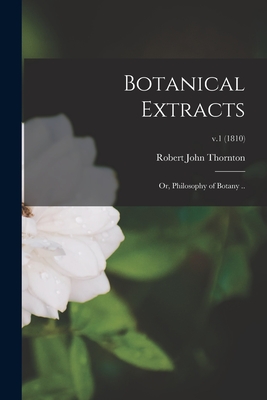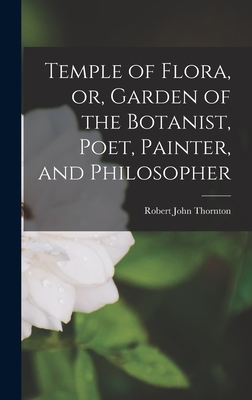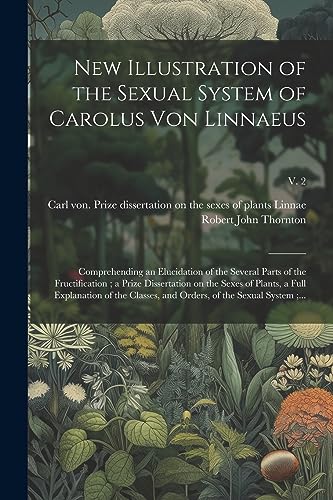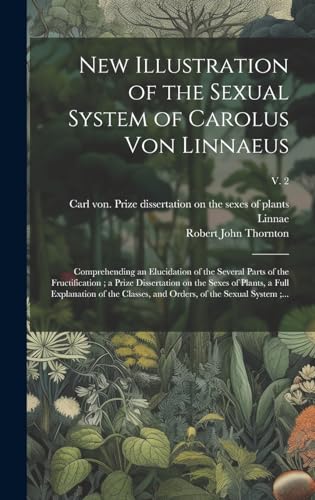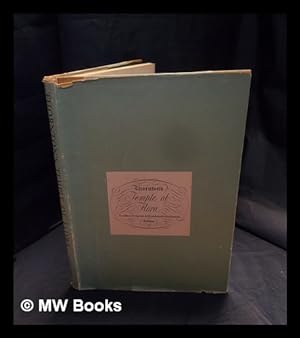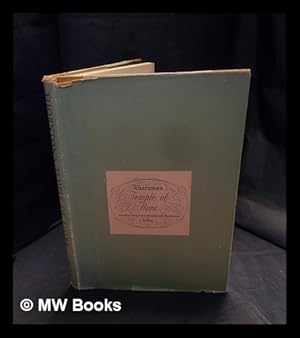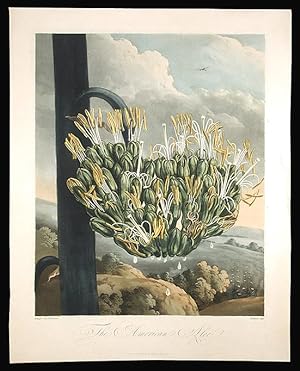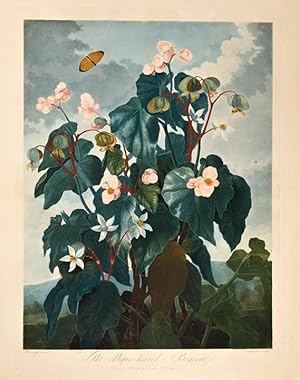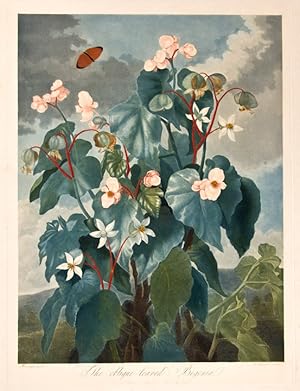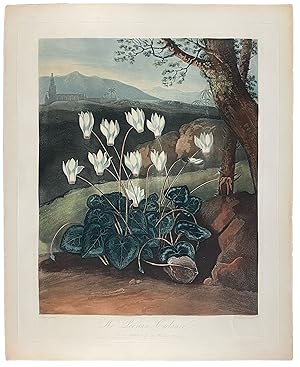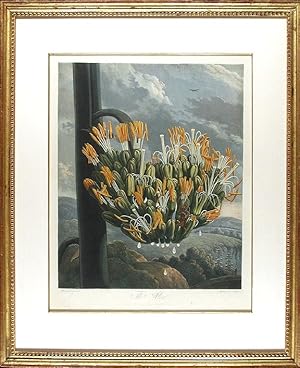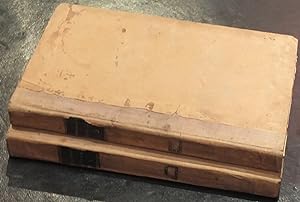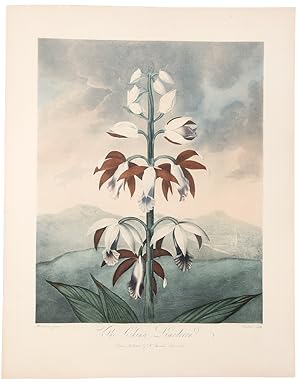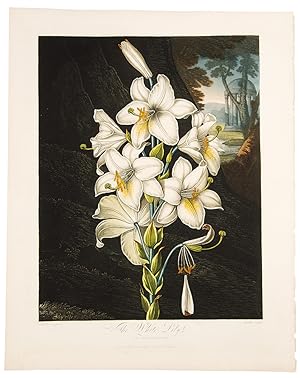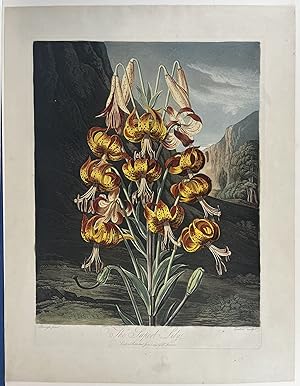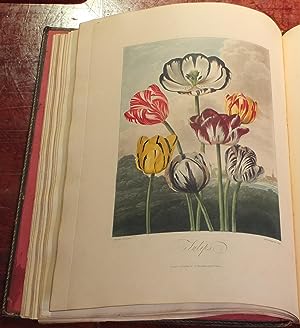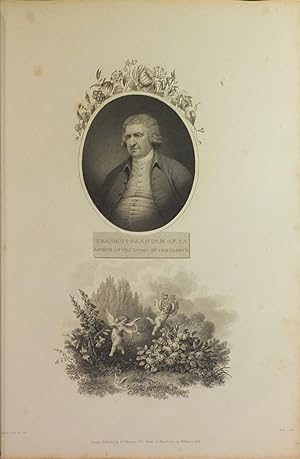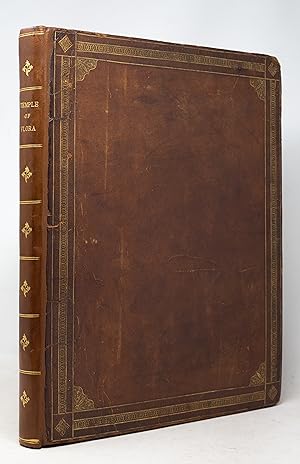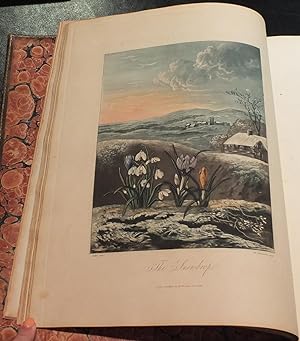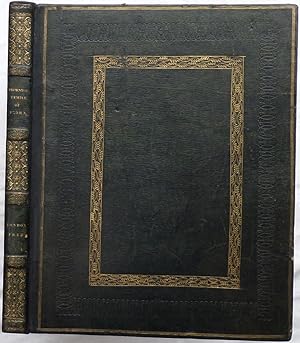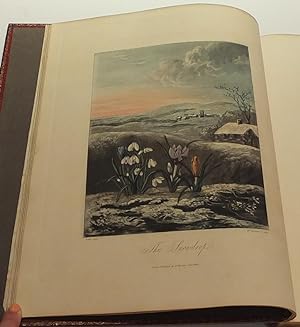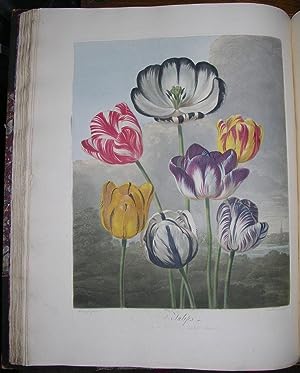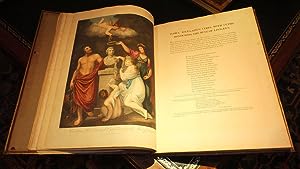robert john 1768 1837 thornton (33 resultados)
Tipo de artículo
- Todo tipo de artículos
- Libros (24)
- Revistas y publicaciones
- Cómics
- Partituras
- Arte, grabados y pósters (9)
- Fotografías
- Mapas
-
Manuscritos y
coleccionismo de papel
Condición
Encuadernación
Más atributos
- Primera edición (8)
- Firmado
- Sobrecubierta (1)
- Con imágenes del vendedor (23)
- Sin impresión bajo demanda (28)
Gastos de envío gratis
Ubicación del vendedor
Valoración de los vendedores
-
Botanical Extracts: or, Philosophy of Botany .; v.1 (1810) (Paperback or Softback)
Publicado por Legare Street Press 9/9/2021, 2021
ISBN 10: 1014100283ISBN 13: 9781014100283
Librería: BargainBookStores, Grand Rapids, MI, Estados Unidos de America
Libro
Paperback or Softback. Condición: New. Botanical Extracts: or, Philosophy of Botany .; v.1 (1810) 1. Book.
Más opciones de compra de otros vendedores en IberLibro
Nuevo desde EUR 25,21
-
Temple of Flora, or, Garden of the Botanist, Poet, Painter, and Philosopher (Hardback or Cased Book)
Publicado por Legare Street Press 10/27/2022, 2022
ISBN 10: 1016185235ISBN 13: 9781016185233
Librería: BargainBookStores, Grand Rapids, MI, Estados Unidos de America
Libro
Hardback or Cased Book. Condición: New. Temple of Flora, or, Garden of the Botanist, Poet, Painter, and Philosopher 1.08. Book.
Más opciones de compra de otros vendedores en IberLibro
Nuevo desde EUR 33,70
-
Temple of Flora, or, Garden of the Botanist, Poet, Painter, and Philosopher
Publicado por Legare Street Press, 2022
ISBN 10: 1016190492ISBN 13: 9781016190497
Librería: THE SAINT BOOKSTORE, Southport, Reino Unido
Libro Impresión bajo demanda
Paperback / softback. Condición: New. This item is printed on demand. New copy - Usually dispatched within 5-9 working days.
-
New Illustration of the Sexual System of Carolus Von Linnaeus: Comprehending an Elucidation of the Several Parts of the Fructification; a Prize Dissertation on the Sexes of Plants, a Full Explanation of the Classes, and Orders, of the Sexual System;.; v. 2
Publicado por Legare Street Press, 2023
ISBN 10: 1021796360ISBN 13: 9781021796363
Librería: THE SAINT BOOKSTORE, Southport, Reino Unido
Libro Impresión bajo demanda
Paperback / softback. Condición: New. This item is printed on demand. New copy - Usually dispatched within 5-9 working days.
-
New Illustration of the Sexual System of Carolus Von Linnaeus: Comprehending an Elucidation of the Several Parts of the Fructification; a Prize Dissertation on the Sexes of Plants, a Full Explanation of the Classes, and Orders, of the Sexual System;.; v. 2
Publicado por Legare Street Press, 2023
ISBN 10: 1019754222ISBN 13: 9781019754221
Librería: THE SAINT BOOKSTORE, Southport, Reino Unido
Libro Impresión bajo demanda
Hardback. Condición: New. This item is printed on demand. New copy - Usually dispatched within 5-9 working days.
-
Thornton's Temple of Flora with Plates faithfully reproduced from the original engravings and the work described by . Grigson with Bibliographical Notes by . Buchanan
Publicado por Collins, London, 1951
Librería: Donald A. Heald Rare Books (ABAA), New York, NY, Estados Unidos de America
Folio. (17 1/16 x 11 7/8 inches). viii, 220pp. Half-title. 36 plates (12 coloured, 24 uncoloured collotypes), each with tissue guard. Tan cloth-backed paper boards, morocco lettering pieces, printed paper label on front board. Dust jacket with printed paper label The standard work on Thornton's masterpiece. Includes the best survey of the various states of the individual plates, together with Grigson's essay on Thornton and the production of this work and botanical notes by William T. Stearn.
-
Temple of Flora : or Garden of the Botanist Poet Painter and Philosopher [English Botanicals, Compiled with Poetry and Philosophy,
Publicado por London : Robert Thornton, 1812 / Reprint / FBRE Ltd., A Bound / Flex Cover / REPRINT, 1812
Librería: GREAT PACIFIC BOOKS, Ventura, CA, Estados Unidos de America
Condición: Very Good. Estado de la sobrecubierta: No Dust Jacket. Fully Illustrated Ilustrador. C: clean and unmarked Text. Modern archival reprint of original edition, no other publication date marked. 110 pages. Illustrations in both b/w and color. Paper / Soft cover reprint edition in very good or better condition, slight wear to edges. Overall good copy of this scarce title. Excellent read. A good book to enjoy and keep on hand. Or would make a great gift for the fan / reader in your life. Review: Spectacular book Temple of Flora ; One of the greatest decorative flower books of the nineteenth century. Dr. Robert Thorton was determined that his country produce the greatest series of botanical illustrations of all time, and his Temple of Flora is unsurpassed as a botanical document of the Romantic era. Thornton assembled the finest flower painters to paint the original designs that served as the basis for the engravings, and no expense was spared in their production. They are the first botanicals to include landscape backgrounds laden with symbolic, sentimental, and dramatic elements. It is the forceful stylization of flowers, as well as their historical, allegorical and/or fanciful backgrounds, that place the Temple of Flora among the greatest botanical books. Excerpt from book: Lines addressed to Dr. Thornton, on his Temple of Flora: THORNTON, while polish'd Darwin a tells, The loves of FLORA's gaudy train, 'Tis thine to guard from time's decay, The fading glories of her reign. // Thy GARDEN of perpetual bloom No change of threat'ning skies can fear; Nor dashing rains, nor chilling blasts, Can reach the lovely fav'rites here. // Bright TULIPA in form as fair, As on the lap of Nature shines; As gaily spreads each opening flow'r, As soft each varying tint combines; // Whether in Asia's sun-bright soil , The Nymph her crimson chalice b rears, Or 'mid Batavia's fost'ring clime c In every added charm appears. // Here view august, in conscious pride, The ALOE lift her standard high; Swell in full pomp her cluster'd flowers, Resolv'd to triumph ere she die. // There CEREA, rich in countless charms, Spreads to the moon her golden ray; Nor fears that, ere yon orb descends, Each blooming grace should fade away. // Behold, in realms of endless spring, MIMOSA's beauteous form arise; While, circling round on festive wing, The ruby-throated spoiler flies. // Here, floating on the evening air, Fair PASSIFLORA scents the gale; Expands her crowns of sapphire blue, And softly waves her petals pale. // FLORA, well pleas'd at Art's success, Each imitative grace shall see; And CUPID, with approving smile, Shall twine his choicest Wreaths for THEE. / Dr. Shaw, British Museum. Book.
-
Thornton's Temple of Flora: with plates faithfully reproduced from the original engravings / and the work described by Geoffrey Grigson, with bibliographical notes by Handasyde Buchanan
Publicado por London : Collins, 1959
Librería: MW Books, New York, NY, Estados Unidos de America
Original o primera edición
1st edition. Near fine cloth over paper-covered boards copy in a very good if slightly edge-nicked and dust-dulled dust-wrapper, now mylar-sleeved. Remains particularly well-preserved overall; tight, bright, clean and strong. Physical description; vi, 66 pp., chiefly illustrations (some color), facsimiles, portrait, 31 cm. Subjects; Thornton, Robert John 1768?-1837. Botany ; Pictorial works. Plants in art. 1 Kg.
-
Thornton's Temple of Flora: with plates faithfully reproduced from the original engravings / and the work described by Geoffrey Grigson, with bibliographical notes by Handasyde Buchanan
Publicado por London : Collins, 1959
Librería: MW Books Ltd., Galway, Irlanda
Original o primera edición
1st edition. Near fine cloth over paper-covered boards copy in a very good if slightly edge-nicked and dust-dulled dust-wrapper, now mylar-sleeved. Remains particularly well-preserved overall; tight, bright, clean and strong. Physical description; vi, 66 pp., chiefly illustrations (some color), facsimiles, portrait, 31 cm. Subjects; Thornton, Robert John 1768?-1837. Botany ; Pictorial works. Plants in art. 1 Kg.
-
Temple of Flora : or Garden of the Botanist Poet Painter and Philosopher [English Botanicals, Compiled with Poetry and Philosophy,
Publicado por London : Robert Thornton, 1812 / Reprint / FBRE Ltd., A Bound / Flex Cover / REPRINT, 1812
Librería: GREAT PACIFIC BOOKS, Ventura, CA, Estados Unidos de America
Condición: Very Good. Estado de la sobrecubierta: No Dust Jacket. Fully Illustrated Ilustrador. C: clean and unmarked Text. Modern archival reprint of original edition, no other publication date marked. 110 pages. Illustrations in both b/w and color. Paper / Soft cover reprint edition in very good or better condition, slight wear to edges. Overall good copy of this scarce title. Excellent read. A good book to enjoy and keep on hand. Or would make a great gift for the fan / reader in your life. Review: Spectacular book Temple of Flora ; One of the greatest decorative flower books of the nineteenth century. Dr. Robert Thorton was determined that his country produce the greatest series of botanical illustrations of all time, and his Temple of Flora is unsurpassed as a botanical document of the Romantic era. Thornton assembled the finest flower painters to paint the original designs that served as the basis for the engravings, and no expense was spared in their production. They are the first botanicals to include landscape backgrounds laden with symbolic, sentimental, and dramatic elements. It is the forceful stylization of flowers, as well as their historical, allegorical and/or fanciful backgrounds, that place the Temple of Flora among the greatest botanical books. Excerpt from book: Lines addressed to Dr. Thornton, on his Temple of Flora: THORNTON, while polish'd Darwin a tells, The loves of FLORA's gaudy train, 'Tis thine to guard from time's decay, The fading glories of her reign. // Thy GARDEN of perpetual bloom No change of threat'ning skies can fear; Nor dashing rains, nor chilling blasts, Can reach the lovely fav'rites here. // Bright TULIPA in form as fair, As on the lap of Nature shines; As gaily spreads each opening flow'r, As soft each varying tint combines; // Whether in Asia's sun-bright soil , The Nymph her crimson chalice b rears, Or 'mid Batavia's fost'ring clime c In every added charm appears. // Here view august, in conscious pride, The ALOE lift her standard high; Swell in full pomp her cluster'd flowers, Resolv'd to triumph ere she die. // There CEREA, rich in countless charms, Spreads to the moon her golden ray; Nor fears that, ere yon orb descends, Each blooming grace should fade away. // Behold, in realms of endless spring, MIMOSA's beauteous form arise; While, circling round on festive wing, The ruby-throated spoiler flies. // Here, floating on the evening air, Fair PASSIFLORA scents the gale; Expands her crowns of sapphire blue, And softly waves her petals pale. // FLORA, well pleas'd at Art's success, Each imitative grace shall see; And CUPID, with approving smile, Shall twine his choicest Wreaths for THEE. / Dr. Shaw, British Museum. Book.
-
The British flora; or, genera and species of British plants: arranged after the reformed sexual system and illustrated by numerous tables, and dissections
Publicado por printed for the author, by J. Whiting, London, 1812
Librería: Flora Books, Mears Ashby, Reino Unido
Full-Leather. Condición: Very Good. 5 volumes, x 3-6 (6) 7-8 11-18 (2) 19-40 (2) 41-86 (2) 87-120: (ii) 3-36 (2) 37-138: (ii) 3-48 (2) 49-102 (6) 107-124 (2) 125-126: (ii) (2) 3-46 (2) 47-58 (2) 59-100: (ii) (2) 5-10 (2) 11-52pp, 311 uncoloured plates in volumes 1-4 and 53 engraved tables at the end of volume 5 (the number of plates seems to vary with a maximum recorded number of 347), attractive contemporary blue crushed morocco (edges and spiine rubbed, several corners lightly bumped), gilt spine and borders, all edges gilt, marbled endpapers, pp3-10 in volume 5 bound out of order and an extra set of pp97-100 of volume 4 bound at the start of volume 5, small portion at the top fore-corner of the front blank of volumes 2 and 4 cut away to remove signature which is still present in volume 3 (J Latham April 1826), plant names in the same neat hand written in ink at the head of the first 36 pages of volume 2, some light offsetting from plates, plate at p93 of volume 2 loose, one plate in volume 4 has a short marginal tear, modern woodcut bookplates on front pastedowns, 8vo (243x144mm), this work was printed as prizes for the Royal Botanic Lottery set up to try to recover the ruinous costs of publishing "The Temple of Flora".
-
Juvenile Botany: being an easy introduction to that delightful science through the medium of familiar conversations.
Publicado por printed for Sherwood, Neely, and Jones, London, 1818
Librería: Flora Books, Mears Ashby, Reino Unido
Half-Leather. Condición: Good. (ii) vi 307 [1]pp, hand coloured frontispiece and 14 other plates (the list of plates only calls for 13, not listing the plate at p203), half calf with marbled boards (heavily rubbed and discoloured, edge-wear with boards showing at the corners), scattered foxing throughout, modern woodcut bookplate by Andy English on front pastedown, bookplate of Claud Lonsdale dated 1895 of the rear pastedown, scarce, 8vo (177x105mm).
-
The American Aloe
Publicado por London, 1807
Librería: Donald A. Heald Rare Books (ABAA), New York, NY, Estados Unidos de America
Arte / Grabado / Póster
Hand-coloured and colour-printed aquatint and line engraving by Medland. The most strikingly beautiful flower plates ever to be printed in England. The present plate was issued as a substitute for an earlier plate titled The Aloe by Thornton ".as the plant shown is not an aloe but an agave [Agave Americana L.]. Aloes are natives of the Old World, their native home being Africa: agaves, though similar in appearance, are inhabitants of the New World. Neither is found wild in the other's territory. Thornton realized his mistake, or had it pointed out to him, [and the present plate was published]. Agaves are, however, familiar under another name as they are the well-known `Century Plants' which are supposed to live a hundred years before flowering, the whole plant dying when the flower-spike decays. In fact, they have been known to flower as early as seven years of age and seldom take longer than twenty-five years. When they flower in glasshouses in the colder countries they present a problem as the flower-spike may rise to thirty feet or more, making it necessary to take out a pane of the roof glass to let the inflorescence rise into the open air. Agave Americana. is often used for making hedges in warmer climates and a variegated form is also much grown as a specimen plant in such countries." (Ronald King,The Temple of Flora by Robert Thornton, 1981, p.70). Thornton's Temple of Flora is the greatest English colour-plate flower book. ".[Thornton] inherited a competent fortune and trained as a doctor. He appears to have had considerable success in practice and was appointed both physician to the Marylebone Dispensary and lecturer in medical botany at Guy's and St. Thomas's hospitals.But quite early in his career he embarked on his.great work.What Redouté produced under the patronage of L'Héritier, Marie Antoinette, the Empress Josephine, Charles X and the Duchesse de Berry, Thornton set out to do alone. Numerous important artists were engaged. twenty-eight paintings of flowers commissioned from Abraham Pether, known as `Moonlight Pether', Philip Reinagle, . Sydenham Edwards, and Peter Henderson.The result.involved Thornton in desperate financial straits.In an attempt to extricate himself he organized the Royal Botanic Lottery, under the patronage of the Prince Regent.it is easy to raise one's eyebrows at Thornton's unworldly and injudicious approach to publishing. But he produced.one of the loveliest books in the world" (Alan Thomas Great Books and Book Collecting, pp.142-144). First and only state of this plate from the Temple of Flora.
-
The Oblique-Leaved Begonia
Publicado por London, 1800
Librería: Donald A. Heald Rare Books (ABAA), New York, NY, Estados Unidos de America
Arte / Grabado / Póster
Hand-coloured and colour-printed aquatint, stipple and line engraving by Caldwell. Sheet size: 21 3/4 x 19 3/4 inches. Fine condition. The most strikingly beautiful flower plates ever to be printed in England. "Begonias as we see them in glasshouse and garden today are a modern development unknown in Thornton's time, when a few species had been introduced to Europe. The particular species he chose for this picture, Begonia nitidia [Dryander], had not long been brought in from Jamaica by Sir Joseph Banks. Regarded as a fine plant then, there was as yet no hint of the important part it was to play one hundred years later in the breeding of the modern small-flowered bedding begonias, Begonis semperflorens. Historically, this picture is of interest as showing a basic species almost at the time it was originally introduced. It is itself an attractive plant with a smooth shiny stem and large glossy green leaves. The way its parts shine, reflecting what light there is, is such an outstanding characteristic of the plant that it provided part of its botanical name: the epithet nitidia means `shining'. That characteristic was superbly captured by the painter Philip Reinagle. and skilfully reproduced by the engraver Caldwell. It is one of Thornton's most attractive and beautiful plates." (Ronald King. The Temple of Flora by Robert Thornton. 1981, p.76). Thornton's Temple of Flora is the greatest English colour-plate flower book. ".[Thornton] inherited a competent fortune and trained as a doctor. He appears to have had considerable success in practice and was appointed both physician to the Marylebone Dispensary and lecturer in medical botany at Guy's and St. Thomas's hospitals. But quite early in his career he embarked on his. great work. What Redouté produced under the patronage of L'Héritier, Marie Antoinette, the Empress Josephine, Charles X and the Duchesse de Berry, Thornton set out to do alone. Numerous important artists were engaged. twenty-eight paintings of flowers commissioned from Abraham Pether, known as `Moonlight Pether', Philip Reinagle, . Sydenham Edwards, and Peter Henderson. The result. involved Thornton in desperate financial straits. In an attempt to extricate himself he organized the Royal Botanic Lottery, under the patronage of the Prince Regent. it is easy to raise one's eyebrows at Thornton's unworldly and injudicious approach to publishing. But he produced. one of the loveliest books in the world" (Alan Thomas Great Books and Book Collecting, pp.142-144). Single state (with minor variations) of this plate from the Temple of Flora. "A very fine plate. with the begonias actually all printed in colour in the early impressions. Minor variations in state only. The mountains which start in pure aquatint are later strengthened with oblique lines, while the horizon is sharper. Later still, the large white cloud at the top right became reduced in size from 1-1 1/2 inches to less than 1/2 inch. [however, the cloud resumed it former size in the latest impressions.] " (Handasyde Buchanan. Thornton's Temple of Flora, 1951, p.17).
-
The Oblique-Leaved Begonia
Publicado por London, 1800
Librería: Donald A. Heald Rare Books (ABAA), New York, NY, Estados Unidos de America
Arte / Grabado / Póster
Hand-coloured and colour-printed aquatint, stipple and line engraving by Caldwell. The most strikingly beautiful flower plates ever to be printed in England. "Begonias as we see them in glasshouse and garden today are a modern development unknown in Thornton's time, when a few species had been introduced to Europe. The particular species he chose for this picture, Begonia nitidia [Dryander], had not long been brought in from Jamaica by Sir Joseph Banks. Regarded as a fine plant then, there was as yet no hint of the important part it was to play one hundred years later in the breeding of the modern small-flowered bedding begonias, Begonis semperflorens. Historically, this picture is of interest as showing a basic species almost at the time it was originally introduced. It is itself an attractive plant with a smooth shiny stem and large glossy green leaves. The way its parts shine, reflecting what light there is, is such an outstanding characteristic of the plant that it provided part of its botanical name: the epithet nitidia means `shining'. That characteristic was superbly captured by the painter Philip Reinagle. and skilfully reproduced by the engraver Caldwell. It is one of Thornton's most attractive and beautiful plates." (Ronald King. The Temple of Flora by Robert Thornton. 1981, p.76). Thornton's Temple of Flora is the greatest English colour-plate flower book. ".[Thornton] inherited a competent fortune and trained as a doctor. He appears to have had considerable success in practice and was appointed both physician to the Marylebone Dispensary and lecturer in medical botany at Guy's and St. Thomas's hospitals. But quite early in his career he embarked on his. great work. What Redouté produced under the patronage of L'Héritier, Marie Antoinette, the Empress Josephine, Charles X and the Duchesse de Berry, Thornton set out to do alone. Numerous important artists were engaged. twenty-eight paintings of flowers commissioned from Abraham Pether, known as `Moonlight Pether', Philip Reinagle, . Sydenham Edwards, and Peter Henderson. The result. involved Thornton in desperate financial straits. In an attempt to extricate himself he organized the Royal Botanic Lottery, under the patronage of the Prince Regent. it is easy to raise one's eyebrows at Thornton's unworldly and injudicious approach to publishing. But he produced. one of the loveliest books in the world" (Alan Thomas Great Books and Book Collecting, pp.142-144). Single state (with minor variations) of this plate from the Temple of Flora. "A very fine plate. with the begonias actually all printed in colour in the early impressions. Minor variations in state only. The mountains which start in pure aquatint are later strengthened with oblique lines, while the horizon is sharper. Later still, the large white cloud at the top right became reduced in size from 1-1 ½ inches to less than ½ inch. [however, the cloud resumed it former size in the latest impressions.] " (Handasyde Buchanan. Thornton's Temple of Flora, 1951, p.17).
-
The Persian Cyclamen
Publicado por London, 1804
Librería: Donald A. Heald Rare Books (ABAA), New York, NY, Estados Unidos de America
Arte / Grabado / Póster
Hand-coloured and colour-printed aquatint, with stipple and line engraving by Elmes. Paper watermarked 1804. First state of three. The most strikingly beautiful flower plates ever to be printed in England. "The Persian Cyclamen [Cyclamen persicum Miller], parent of the florist's cyclamen. is a native of the countries and islands at the eastern end of the Mediterranean but not of Persia itself. It is the largest flowered of an attractive genus of small plants much grown in modern times by connoisseurs. The Persian Cyclamen was not the first of its kind to become known in western Europe. Cyclamen europeaum, the `Bleeding Nun', as it was called, was thought to be dangerous to pregnant women: any unfortunate lady in this condition who stepped over it might immediately miscarry. John Gerrard, the Elizabethan herbalist, believed this implicitly and describes how he fenced his plants around with sticks with others laid across them `lest any woman should, by lamentable experiment, find my words to be true, by stepping over the same.' When the baby was nearing full term, and delivery was to be encouraged, wearing of the disc-like tuber, `hanged about' the expectant mothers, had a salutary effect, and Gerrard told his wife to use it when attending confinements. Its use by midwifes dates back to the days of the Greeks." (Ronald King. The Temple of Flora by Robert Thornton. 1981, p. 52). Thornton's Temple of Flora is the greatest English colour-plate flower book. ".[Thornton] inherited a competent fortune and trained as a doctor. He appears to have had considerable success in practice and was appointed both physician to the Marylebone Dispensary and lecturer in medical botany at Guy's and St. Thomas's hospitals. But quite early in his career he embarked on his. great work. What Redouté produced under the patronage of L'Héritier, Marie Antoinette, the Empress Josephine, Charles X and the Duchesse de Berry, Thornton set out to do alone. Numerous important artists were engaged. twenty-eight paintings of flowers commissioned from Abraham Pether, known as `Moonlight Pether', Philip Reinagle, . Sydenham Edwards, and Peter Henderson. The result. involved Thornton in desperate financial straits. In an attempt to extricate himself he organized the Royal Botanic Lottery, under the patronage of the Prince Regent. it is easy to raise one's eyebrows at Thornton's unworldly and injudicious approach to publishing. But he produced. one of the loveliest books in the world" (Alan Thomas Great Books and Book Collecting, pp.142-144). Third state of three of this plate from the Temple of Flora. `In the first state the top the castle is indistinct and has no pinnacles on the towers, and this is the first feature to inspect. The hillside is pure aquatint; the shading behind the cyclamen flowers is lightly cross-hatched, while the tree trunk to the right has only a few lines on it. In the second state the castle is more prominent and five distinct sharp pinnacles have been added, while many extra etched lines are to be seen - notably behind the cyclamen flowers; on the tree trunk; and under the cyclamen leaves on the left, which themselves stand out more sharply. The principal change in the third state is the addition of the aquatint to the sky on the left, so that only a streak of light remains above the mountains, while in the earlier states the light reached the top corner. The leaves of the cyclamen [now have]. light and dark patches, the coarse-grained aquatint has been added to the middle distance. Much additional aquatinting has been applied to other parts of the plate. The most easily-noticed difference, however, are the changes in the castle between states one and two, and in the sky between states two three." (Handasyde Buchanan. Thornton's Temple of Flora, 1951, p.15).
-
The Aloe
Publicado por London, 1798
Librería: Donald A. Heald Rare Books (ABAA), New York, NY, Estados Unidos de America
Arte / Grabado / Póster
Hand-coloured and colour-printed aquatint and line engraving by Medland. Sight size: 19 1/2 x 15 1/4 inches. Gold-leaf frame, "Amiran" archival glass, with UV protection and an anti-reflective surface. Framed size: 27 3/4 x 22 3/4 inches. The most strikingly beautiful flower plates ever to be printed in England. "This plate was incorrectly titled by Thornton, as the plant shown is not an aloe but an agave [Agave Americana L.]. Aloes are natives of the Old World, their native home being Africa: agaves, though similar in appearance, are inhabitants of the New World. Neither is found wild in the other's territory. Thornton realized his mistake, or had it pointed out to him, and named a second picture of the same plant published later 'The American Aloe.' Agaves are, however, familiar under another name as they are the well-known 'Century Plants' which are supposed to live a hundred years before flowering, the whole plant dying when the flower-spike decays. In fact, they have been known to flower as early as seven years of age and seldom take longer than twenty-five years. When they flower in glasshouses in the colder countries they present a problem as the flower-spike may rise to thirty feet or more, making it necessary to take out a pane of the roof glass to let the inflorescence rise into the open air. Agave Americana.is often used for making hedges in warmer climates and a variegated form is also much grown as a specimen plant in such countries" (Ronald King,The Temple of Flora by Robert Thornton, 1981, p.70). Thornton's The Temple of Flora is the greatest English colour-plate flower book. ".[Thornton] inherited a competent fortune and trained as a doctor. He appears to have had considerable success in practice and was appointed both physician to the Marylebone Dispensary and lecturer in medical botany at Guy's and St. Thomas's hospitals. But quite early in his career he embarked on his.great work. What Redouté produced under the patronage of L'Héritier, Marie Antoinette, the Empress Josephine, Charles X, and the Duchesse de Berry, Thornton set out to do alone.Numerous important artists were engaged.twenty-eight paintings of flowers [were] commissioned from Abraham Pether, known as 'Moonlight Pether,' Philip Reinagle,.Sydenham Edwards, and Peter Henderson.The result.involved Thornton in desperate financial straits.In an attempt to extricate himself he organized the Royal Botanic Lottery, under the patronage of the Prince Regent.It is easy to raise one's eyebrows at Thornton's unworldly and injudicious approach to publishing.But he produced.one of the loveliest books in the world" (Alan Thomas, Great Books and Book Collecting, pp.142-144). Second state of two of this plate from The Temple of Flora. "There are two states of this plate, but while the superficial differences are small, their effect is considerable.[The first issue includes a pinky tinge to the sky which is not present in the second issue].The principal changes in the second state are a certain amount of rework on the foliage of the Aloe, and on the sky." (Handasyde Buchanan, Thornton's The Temple of Flora, 1951, p.16).
-
The Indian Reed
Publicado por London, 1804
Librería: Donald A. Heald Rare Books (ABAA), New York, NY, Estados Unidos de America
Arte / Grabado / Póster
Hand-coloured and colour-printed in aquatint and line by Caldwell. Sight size: 20 x 15 1/4 inches. Gold-leaf frame, "Amiran" archival glass, with UV protection and an anti-reflective surface. Framed size: 27 3/4 x 22 3/4 inches. The most strikingly beautiful flower plates ever to be printed in England. A very fine view of the exotic Indian Reed Canna indica L. Thornton, during "the colour-finishing by hand.got his colourists to add five petals, one in each flower, and a long pointed bud at the top of the spike. The final process of hand-colouring.added greatly to the effectiveness of a number of Thornton's plates.but this is the only one where he took such.action that it altered the character of the plate.[For the second state Henderson effectively replaced the hand-painted changes of the first state] and the augmented red flower spike stands out boldly against the sky. The large leaves at the bottom are beautifully lit. The plant itself, Canna indica, the well-known garden plant still much used for formal bedding, needs no description. The background river is presumably the Ganges, and the tall pagoda adds an eastern touch" (Ronald King, The Temple of Flora by Robert Thornton, 1981, p.106). Thornton's The Temple of Flora is the greatest English colour-plate flower book. ".[Thornton] inherited a competent fortune and trained as a doctor. He appears to have had considerable success in practice and was appointed both physician to the Marylebone Dispensary and lecturer in medical botany at Guy's and St. Thomas's hospitals. But quite early in his career he embarked on his.great work. What Redouté produced under the patronage of L'Héritier, Marie Antoinette, the Empress Josephine, Charles X, and the Duchesse de Berry, Thornton set out to do alone.Numerous important artists were engaged.twenty-eight paintings of flowers [were] commissioned from Abraham Pether, known as 'Moonlight Pether,' Philip Reinagle,.Sydenham Edwards, and Peter Henderson.The result.involved Thornton in desperate financial straits.In an attempt to extricate himself he organized the Royal Botanic Lottery, under the patronage of the Prince Regent.It is easy to raise one's eyebrows at Thornton's unworldly and injudicious approach to publishing.But he produced.one of the loveliest books in the world" (Alan Thomas, Great Books and Book Collecting, pp.142-144).
-
Elements of Botany.
Publicado por London: For the Author by J. Whiting, 1812., 1812
Librería: Arader Galleries - AraderNYC, New York, NY, Estados Unidos de America
Original o primera edición
"2 volumes. 8vo., (9 ½ x 6 ? inches). Half-titles, 24 engraved sectional title pages (browned and spotted throughout). 176 fine engraved plates (a couple of plates detaching, some spotting and marginal staining). Original publisher's drab paper boards, muslin spines with black morocco gilt spine labels (a bit stained, paper labels worn at edges). Provenance: With the manuscript ownership inscription of J. R. Riggs dated 1854 in both volumes. First edition. IN ORIGINAL PUBLISHER'S PAPER BOARDS. Thornton was destined for a career in the church, but while at Trinity College, Cambridge he found inspiration in the botanical lectures of Thomas Martyn and switched to studying medicine. He went on to lecture in medical botany at Guy's Hospital. "In 1811 he obtained an act of parliament (51 Geo. III, cap. 103), authorizing him to organize a lottery of his botanical works, and this was advertised as 'The Royal Botanical Lottery, under the patronage of the prince regent, of twenty thousand tickets at two guineas each, and ten thousand prizes, of a total value exceeding 77,000l.' The first prize was the collection of original pictures at that date on exhibition at the European Museum, King Street, St. James's which was valued at over five thousand pounds. The second class of prizes consisted of copies of 'The Temple of Flora,' 'in five folio volumes;' the third class, of sets of the plates coloured; the fourth class, of the quarto edition; the fifth class, of the 'British Flora' (5 vols. 8vo, with four hundred plates); and the sixth class, of the 'Elements of Botany' [as here] The lottery does not appear to have proved remunerative; and in spite of his numerous subsequent publications, when Thornton died on 21 Jan. 1837, he left his family very poor" (DNB). Nissen 1952.".
-
The China Limodoron
Publicado por London, 1802
Librería: Donald A. Heald Rare Books (ABAA), New York, NY, Estados Unidos de America
Arte / Grabado / Póster
Hand-coloured and colour-printed in aquatint, engraving by Landseer. First state. The most strikingly beautiful flower plates ever to be printed in England. "This noble evergreen orchid [the China Limodoron Phaius Tankervillae (Banks) Blume, Phaius grandifolius], native of the lands from China to Australia, was introduced to England from China in 1778 by Dr Fothergill, an eminent and wealthy physician who had a garden at Upton in Essex with a 260-foot glasshouse adjoining the house. It was doubtless in this glasshouse that the plant was first grown. Its many-flowered spikes, from two to four feet high, which are produced from February and March, are fine for exhibition and withstand cutting well. Individual flowers are from three to four inches across. Thornton's name for the plant. is a corruption of Limodorum, the botanical name of the genus in which the plant was placed in his time. The plate.represents the plant very well. The landscape behind is unobtrusive and contains little to distract the viewer. The beauty of the plant is left to make its own impact. In Thornton's day this must have been tremendous, as few exotic orchids had as yet been flowered in Europe and it was to be another twenty years before their culture began to be understood." (Ronald King, The Temple of Flora by Robert Thornton, 1981, p.104). Thornton's Temple of Flora is the greatest English colour-plate flower book. ".[Thornton] inherited a competent fortune and trained as a doctor. He appears to have had considerable success in practice and was appointed both physician to the Marylebone Dispensary and lecturer in medical botany at Guy's and St. Thomas's hospitals. But quite early in his career he embarked on his. great work. What Redouté produced under the patronage of L'Héritier, Marie Antoinette, the Empress Josephine, Charles X and the Duchesse de Berry, Thornton set out to do alone.Numerous important artists were engaged. twenty-eight paintings of flowers commissioned from Abraham Pether, known as `Moonlight Pether', Philip Reinagle, . Sydenham Edwards, and Peter Henderson.The result.involved Thornton in desperate financial straits. In an attempt to extricate himself he organized the Royal Botanic Lottery, under the patronage of the Prince Regent.it is easy to raise one's eyebrows at Thornton's unworldly and injudicious approach to publishing.But he produced.one of the loveliest books in the world" (Alan Thomas Great Books and Book Collecting, pp.142-144).
-
The White Lily
Publicado por London, 1800
Librería: Donald A. Heald Rare Books (ABAA), New York, NY, Estados Unidos de America
Arte / Grabado / Póster
Hand-coloured and colour-printed aquatint engraving by Stadler. Second state of four. The most strikingly beautiful flower plates ever to be printed in England. "The White Lily [with variegated leaves Lilium candidum L. var. aureomarginatum], now often called the Madonna Lily, is one of the oldest companions of mankind and, in the. purity of its appearance, one of the loveliest. Known and loved in ancient Greece and Crete, it was known and cherished also by many other nations of the ancient world, including even the. Assyrians, who carved it in their bas-reliefs. It was given its Latin name by the Roman poet Virgil and seems to have been taken by the Romans everywhere they went, since it is found apparently wild in nearly all the countries of their former empire, although modern science suggests that it is native. to Mediterranean countries and those of south-west Asia. Bartholomaeus Anglicus, one of the first English writers to mention plants, writing at the end of the thirteenth century, captured in a superb sentence the very essence of this plant, `the Lilye is an herbe with a white floure: and though the leves of the floure be white yet within shyneth the lykness of gold.' In the Christian religion, as its modern name implies, it has for long been associated with the Virgin Mary. The plant portrayed in this plate is a rare form with yellow-margined leaves. [The image] is noteworthy for its very dark background, chosen to set off the light colours of the flowers and leaves." (Ronald King. The Temple of Flora by Robert Thornton. 1981, p.86). Thornton's Temple of Flora is the greatest English colour-plate flower book. ".[Thornton] inherited a competent fortune and trained as a doctor. He appears to have had considerable success in practice and was appointed both physician to the Marylebone Dispensary and lecturer in medical botany at Guy's and St. Thomas's hospitals. But quite early in his career he embarked on his. great work. What Redouté produced under the patronage of L'Héritier, Marie Antoinette, the Empress Josephine, Charles X and the Duchesse de Berry, Thornton set out to do alone. Numerous important artists were engaged. twenty-eight paintings of flowers commissioned from Abraham Pether, known as `Moonlight Pether', Philip Reinagle, . Sydenham Edwards, and Peter Henderson. The result. involved Thornton in desperate financial straits. In an attempt to extricate himself he organized the Royal Botanic Lottery, under the patronage of the Prince Regent. it is easy to raise one's eyebrows at Thornton's unworldly and injudicious approach to publishing. But he produced. one of the loveliest books in the world" (Alan Thomas Great Books and Book Collecting, pp.142-144).
-
The Superb Lily
Publicado por London, 1799
Librería: Donald A. Heald Rare Books (ABAA), New York, NY, Estados Unidos de America
Arte / Grabado / Póster
Sheet size 23 x 17 inches. Hand-coloured and colour-printed mezzotint engraving by Earlom. The most strikingly beautiful flower plates ever to be printed in England. The most strikingly beautiful flower plates ever to be printed in England. "Truly a magnificent sight in full flower, this plant is rightly named the Superb Lily [Lilium superbum L.]. A native of eastern North America, it stands robustly upright on its stout purple-tinged stem, often reaching six feet in height, and unfolds in July and August thickly spotted orange-red flowers, each of which may be four inches long, in numbers which may be as few as six, but have been known to reach as many as forty, although somewhere between twelve and twenty-five is more usual.The picture was painted by Philip Reinagle. Thornton appears to have been confident that it would sell well, since he had two plates of it engraved, one by Ward and the other by Earlom, both executed in mezzotint. They differ little from one another. Again, as in the plate of the White Lily, the inflorescence is shown against a dark background, but less dark than in the case of the White Lily because the striking colour of the flowers stands out boldly in its own right. The picture does full justice to this noble plant and the Superb Lily is one of the most popular of Thornton's plates" (Ronald King, The Temple of Flora by Robert Thornton, 1981, p.88). Thornton's The Temple of Flora is the greatest English colour-plate flower book. ".[Thornton] inherited a competent fortune and trained as a doctor. He appears to have had considerable success in practice and was appointed both physician to the Marylebone Dispensary and lecturer in medical botany at Guy's and St. Thomas's hospitals. But quite early in his career he embarked on his.great work. What Redouté produced under the patronage of L'Héritier, Marie Antoinette, the Empress Josephine, Charles X, and the Duchesse de Berry, Thornton set out to do alone.Numerous important artists were engaged.twenty-eight paintings of flowers [were] commissioned from Abraham Pether, known as 'Moonlight Pether,' Philip Reinagle,.Sydenham Edwards, and Peter Henderson.The result.involved Thornton in desperate financial straits.In an attempt to extricate himself he organized the Royal Botanic Lottery, under the patronage of the Prince Regent.It is easy to raise one's eyebrows at Thornton's unworldly and injudicious approach to publishing.But he produced.one of the loveliest books in the world" (Alan Thomas, Great Books and Book Collecting, pp.142-144).
-
Temple of Flora or Garden of the Botanist, Poet, Painter, and Philosopher.
Publicado por London: [for the author], 1812., 1812
Librería: Arader Galleries - AraderNYC, New York, NY, Estados Unidos de America
Original o primera edición
4to (15 ? x 12 ? inches). Aquatint frontispiece by Cosway after Burke, engraved title over two leaves with vignette headpiece to first leaf by Tomkins after Burney; 2 stipple engravings by Russell and Opie after Maddocks, and Reinagle after Bartolozzi and Landseer, 28 hand-colored aquatints by Pether, Thornton, Edwards, Reinagle & Henderson, after drawings by Dunkarten, Roffe, Gaugain, Quilley, Maddox, Burk, Maddan and Stadler (lightly browned throughout, occasional spotting and thumbing). Contemporary green straight-grained morocco, elaborately decorated in gilt and blind, all edges gilt (over-opened, extremities worn with some loss). THORNTON'S MASTERPIECE First quarto edition, with an additional plate: "Artichoke Protea" by Quilley after Henderson, not included in the original folio edition of 1807 published under the title "New Illustrations of the Sexual System of Linnaeus". Other images are reduced copies of those in the folio edition. According to Dunthorne, the quarto edition was published initially as fourth level prizes in the lottery that Thornton ran in an attempt to recoup the losses he had incurred during the production of the folio edition. Thornton's "Temple of Flora" was a "gigantic literary speculation which was to ruin him. This work. was first advertised in 1797 and began to appear in parts from 1799, published by T. Bensley and priced at 1 guinea (later 25s). The complete text with illustrations was advertised as available in 1799 for 20 guineas. Its bibliographic history was complicated, the three main parts being issued at a variety of times and in different formats. . The huge costs of illustration and printing seriously eroded Thornton's personal fortune. As a promotional exercise in 1804 he exhibited the originals of his plates at 49 New Bond Street, and in 1811 an act of parliament (51 George III, cap. 103) authorized his 'Royal Botanical Lottery', for which he issued 20,000 tickets at 2 guineas each. The top prize was the set of original paintings, with other prizes of his printed illustrations and texts. In spite of his efforts to market his publications, his finances never recovered. At the heart of the New Illustration was Thornton's scheme to produce a specifically British botanical publication of a magnificence to surpass all previous examples. Teams of master engravers and colourists, including Francesco Bartolozzi, Richard Earlom, and John Landseer, used the full range of modern printing techniques to produce coloured illustrations after paintings by such prominent artists as Sir William Beechey, James Opie, Henry Raeburn, John Russell, Abraham Pether, and his two favoured illustrators, Peter Henderson and Philip Reinagle. The illustrations were not restricted to the 'choicest flowers' in the world, but included portraits of eminent botanists-including the famous portrait of Linnaeus in Lapp (Sami) dress-elaborate allegories, such as 'Cupid Inspiring the Plants to Love', and a bust of Linnaeus being honoured by Aesculapius, Flora, Ceres, and Cupid. The text, which includes a translation of Linnaeus's 'Prize dissertation' on the sexuality of plants (1759), is similarly not bound to accounts and texts of scientific botany, but deals with a wide range of religious, political, spiritual, social, and emotional issues, not only in prose but also through extensive use of poems by modern and ancient authors. It is easy to regard much of this material as irrelevant to the publication's botanical aims, but this is to miss the universal human and religious purposes of botanical learning in Thornton's system of thought" (Martin Kemp for DNB). Thornton was destined for a career in the church, but while at Trinity College, Cambridge he found inspiration in the botanical lectures of Thomas Martyn and switched to studying medicine. He went on to lecture in medical botany at Guy's Hospital. Conceived on a grandiose scale, Thornton's work was to comprise three parts: a dissertation on the sexual reproductive c.
-
Elementary Botanical Plates Illustrative of the Science of Botany.
Publicado por London: T. Bensley for the Publishers. and the Author, 1810., 1810
Librería: Arader Galleries - AraderNYC, New York, NY, Estados Unidos de America
THORNTON, Robert John (1768-1837). Elementary Botanical Plates Illustrative of the Science of Botany. London: T. Bensley for the Publishers. and the Author, 1810. 2 volumes. Folio (18 4/8 x 13 inches). Volume I: Letterpress title-page. Engraved allegorical frontispiece by Ridley after Russell and Opie, engraved portrait and dedication, 26 further portraits of botanists, view of Litchfield Cathedral, and 74 engraved, mezzotint, and aquatint plates of botanical, scientific, and other subjects, 3 double-page or folding (few plates with light scattered foxing mostly confined to margins, one folding plate with stub-tear, one caption shaved). Volume II: "A New Illustration of the Sexual System of Linnaeus" (engraved title-page for volume I, misbound). London: for the Author by T. Bensley, 1799 [some watermarks 1805]. Engraved frontispiece by Bartolozzi and Landseer after Reinagle, engraved and letterpress titles, 89 engraved, mezzotint, and aquatint botanical plates, one folded, 2 double-page, followed by 2 further engraved title-pages by Vincent after Tomkins (general title ending "Including," second title beginning "The Genera"), letterpress dedication of "Part the Second", plate of classes by number of stamen, 3 plates of Analyses and 2 of "Explanations of Class" 1 (occasional light foxing, a few of the larger plates with captions or image shaved). Contemporary diced russia, each cover with an elaborate border in blind and gilt with multiple fillets, and repeated palmette, alpinia and fern tools, inner gilt dentelles with repeated mantlepiece-like devices, spines gilt in compartments lettered with "Thornton's Philosophy of Botany," volume numbers 3 and 4, and date "1810," and with symmetrical arrangements of floral and foliate tools in the others, all edges gilt (extremities a bit rubbed, spine edges more so, joints weak). Volumes III and IV of "The Philosophy of Botany", composed of parts of Thornton's "New Illustration of the Sexual System of Carolus von Linnaeus". Although the majority of the plates are botanic, two depict volcanic eruptions, and two show the harvesting and drinking of tea. Volumes one and two, Botanical Extracts or Philosophy of Botany, not present here, are mostly text with only two engraved plates of portraits and one or two botanical plates. The work is described as a "bibliographer's nightmare" by Stafleu & Cowan, with plate counts and states varying, but the present copies seem to be the later issue. Nissen BBI 1956; Stafleu & Cowan TL2 14284.
-
Temple of Flora or Garden of the Botanist, Poet, Painter, and Philosopher.
Publicado por London: [for the author], 1812., 1812
Librería: Arader Galleries - AraderNYC, New York, NY, Estados Unidos de America
Original o primera edición
Large 4to (15 2/8 x 12 2/8 inches). Aquatint frontispiece by Cosway after Burke (misbound), engraved title-page over two leaves with vignette headpiece to first leaf by Tomkins after Burney; 2 stipple engravings by Russell and Opie after Maddocks, and Reinagle after Bartolozzi and Landseer, 28 hand-colored aquatints by Pether, Thornton, Edwards, Reinagle & Henderson, after drawings by Dunkarten, Roffe, Gaugain, Quilley, Maddox, Burk, Maddan and Stadler (lightly browned, marginal thumbing throughout). Contemporary tan calf decorated in gilt and blind (rebacked, extremities quite worn with loss, surface abrasions). Provenance: modern ownership inscription at the head of the title-page. THORNTON'S MASTERPIECE First quarto edition, with an additional plate: "Artichoke Protea" by Quilley after Henderson, not included in the original folio edition of 1807 published under the title "New Illustrations of the Sexual System of Linnaeus". Other images are reduced copies of those in the folio edition. According to Dunthorne, the quarto edition was published initially as fourth level prizes in the lottery that Thornton ran in an attempt to recoup the losses he had incurred during the production of the folio edition. Thornton's "Temple of Flora" was a "gigantic literary speculation which was to ruin him. This work, . was first advertised in 1797 and began to appear in parts from 1799, published by T. Bensley and priced at 1 guinea (later 25s). The complete text with illustrations was advertised as available in 1799 for 20 guineas. Its bibliographic history was complicated, the three main parts being issued at a variety of times and in different formats. . The huge costs of illustration and printing seriously eroded Thornton's personal fortune. As a promotional exercise in 1804 he exhibited the originals of his plates at 49 New Bond Street, and in 1811 an act of parliament (51 George III, cap. 103) authorized his 'Royal Botanical Lottery', for which he issued 20,000 tickets at 2 guineas each. The top prize was the set of original paintings, with other prizes of his printed illustrations and texts. In spite of his efforts to market his publications, his finances never recovered. At the heart of the New Illustration was Thornton's scheme to produce a specifically British botanical publication of a magnificence to surpass all previous examples. Teams of master engravers and colourists, including Francesco Bartolozzi, Richard Earlom, and John Landseer, used the full range of modern printing techniques to produce coloured illustrations after paintings by such prominent artists as Sir William Beechey, James Opie, Henry Raeburn, John Russell, Abraham Pether, and his two favoured illustrators, Peter Henderson and Philip Reinagle. The illustrations were not restricted to the 'choicest flowers' in the world, but included portraits of eminent botanists-including the famous portrait of Linnaeus in Lapp (Sami) dress-elaborate allegories, such as 'Cupid Inspiring the Plants to Love', and a bust of Linnaeus being honoured by Aesculapius, Flora, Ceres, and Cupid. The text, which includes a translation of Linnaeus's 'Prize dissertation' on the sexuality of plants (1759), is similarly not bound to accounts and texts of scientific botany, but deals with a wide range of religious, political, spiritual, social, and emotional issues, not only in prose but also through extensive use of poems by modern and ancient authors. It is easy to regard much of this material as irrelevant to the publication's botanical aims, but this is to miss the universal human and religious purposes of botanical learning in Thornton's system of thought" (Martin Kemp for DNB). Thornton was destined for a career in the church, but while at Trinity College, Cambridge he found inspiration in the botanical lectures of Thomas Martyn and switched to studying medicine. He went on to lecture in medical botany at Guy's Hospital. Conceived on a grandiose scale, Thornton's work was to comprise three.
-
Temple of Flora or Garden of the Botanist, Poet, Painter, and Philosopher.
Publicado por London: [for the author], 1812., 1812
Librería: Arader Galleries - AraderNYC, New York, NY, Estados Unidos de America
Original o primera edición
Large 4to (14 6/8 x 11 5/8 inches). Aquatint frontispiece by Cosway after Burke, engraved title over two leaves with vignette headpiece to first leaf by Tomkins after Burney; 2 stipple engravings by Russell and Opie after Maddocks, and Reinagle after Bartolozzi and Landseer, 28 hand-colored aquatints by Pether, Thornton, Edwards, Reinagle & Henderson, after drawings by Dunkarten, Roffe, Gaugain, Quilley, Maddox, Burk, Maddan and Stadler (lightly browned throughout, occasional spotting and thumbing). Contemporary green morocco, elaborately decorated in gilt and blind (rebacked, extremities scuffed). THORNTON'S MASTERPIECE First quarto edition, with an additional plate: "Artichoke Protea" by Quilley after Henderson, not included in the original folio edition of 1807 published under the title "New Illustrations of the Sexual System of Linnaeus". Other images are reduced copies of those in the folio edition. According to Dunthorne, the quarto edition was published initially as fourth level prizes in the lottery that Thornton ran in an attempt to recoup the losses he had incurred during the production of the folio edition. Thornton's "Temple of Flora" was a "gigantic literary speculation which was to ruin him. This work, . was first advertised in 1797 and began to appear in parts from 1799, published by T. Bensley and priced at 1 guinea (later 25s). The complete text with illustrations was advertised as available in 1799 for 20 guineas. Its bibliographic history was complicated, the three main parts being issued at a variety of times and in different formats. . The huge costs of illustration and printing seriously eroded Thornton's personal fortune. As a promotional exercise in 1804 he exhibited the originals of his plates at 49 New Bond Street, and in 1811 an act of parliament (51 George III, cap. 103) authorized his 'Royal Botanical Lottery', for which he issued 20,000 tickets at 2 guineas each. The top prize was the set of original paintings, with other prizes of his printed illustrations and texts. In spite of his efforts to market his publications, his finances never recovered. At the heart of the New Illustration was Thornton's scheme to produce a specifically British botanical publication of a magnificence to surpass all previous examples. Teams of master engravers and colourists, including Francesco Bartolozzi, Richard Earlom, and John Landseer, used the full range of modern printing techniques to produce coloured illustrations after paintings by such prominent artists as Sir William Beechey, James Opie, Henry Raeburn, John Russell, Abraham Pether, and his two favoured illustrators, Peter Henderson and Philip Reinagle. The illustrations were not restricted to the 'choicest flowers' in the world, but included portraits of eminent botanists-including the famous portrait of Linnaeus in Lapp (Sami) dress-elaborate allegories, such as 'Cupid Inspiring the Plants to Love', and a bust of Linnaeus being honoured by Aesculapius, Flora, Ceres, and Cupid. The text, which includes a translation of Linnaeus's 'Prize dissertation' on the sexuality of plants (1759), is similarly not bound to accounts and texts of scientific botany, but deals with a wide range of religious, political, spiritual, social, and emotional issues, not only in prose but also through extensive use of poems by modern and ancient authors. It is easy to regard much of this material as irrelevant to the publication's botanical aims, but this is to miss the universal human and religious purposes of botanical learning in Thornton's system of thought" (Martin Kemp for DNB) Thornton was destined for a career in the church, but while at Trinity College, Cambridge he found inspiration in the botanical lectures of Thomas Martyn and switched to studying medicine. He went on to lecture in medical botany at Guy's Hospital. Conceived on a grandiose scale, Thornton's work was to comprise three parts: a dissertation on the sexual reproductive cycle of plates; an explanation of Lin.
-
Temple of Flora. or Garden of the Botanist, Poet, Painter and Philosopher,
Publicado por Dr. Thornton, London:, 1812
Librería: Madoc Books (ABA-ILAB), Llandudno, CONWY, Reino Unido
Libro
Hardcover. Condición: Very Good. The Most Spectacular Botanical Print Book of its Era. First quarto edition, large quarto, [45] leaves, engraved title on two leaves, hand coloured allegorical aquatint frontispieces, two uncoloured engraved plates (the first by Maddocks after Russel and Opie, the second by Bartolozzi and Landseer after Reinagle), and twenty eight stipple engraved, mezzotint, or aquatint colour botanical plates by Wm. Dunkarton, R. Rosse, Gaugain, Staeler, Quilley, Maddox, Roffe, D. Maddan, Stadler, after Pether, R.J. Thornton, S. Edwards, Reinagle, Henderson, some hand coloured, some partially printed in colours and finished by hand (including The Persian Cyclamen, not found in some copies). Text watermarked 1810 and 1811; plates watermarked 1811. Contemporary full black straight grain morocco, covers with gilt and blind stamped borders, three spine compartments densely gilt tooled, the other two with gilt lettering, gilt board edges and turn-ins, marbled endpapers, all edges gilt, front joint expertly repaired. (377*300 mm). (Dunthorpe 302. Great Flower Books p77. Plesch p433). The high point of Romantic era botanical books and the first floral prints with landscape backgrounds. In 1798 there appeared the first of a series of some thirty large colour plates which are unique in that they produce the first flower prints with landscape backgrounds, depicting the natural habitat of the plant. The life size flowers stand forth dramatically and the whole effect is startlingly modern. This large folio, entitled The Temple of Flora or New Illustrations of the Sexual System of Linnaeus, was published by Dr Robert John Thornton a lecturer on medical botany at Guy?s Hospital in London. His announced intention was to make this work the most magnificent tribute ever paid to the famous Swedish botanist by illustrating his Sexual System with the finest possible prints. It was a work on which no expense was spared. Such important artists were employed to produce the designs as Reinagle, Pether, Hernderson and Sydenham Edwards. The best of the contemporary engravers, numbering among the mezzo tinters the well known Ward, Earlom, and Dunkarton, and among the aquatint engravers, Stadler and Sutherland, were engaged tp prepare the plates. By appealing to Parliament [Thornton] was authorised to hold a lottery in 1811, and to issue twenty thousand tickets at two guineas each: the value of the prizes amounting to seventy thousand pounds. The first prize. consisted of the original paintings for the Temple of Flora. The 2nd prize were complete sets of the colour prints. The 3rd, some of Thornton?s botanical writings. A beautiful copy with the plates clean and vivid and virtually no offsetting.
-
Temple of Flora, or Garden of the Botanist poet, Painter and Philosopher.
Publicado por London: for the author 1812., 1812
Librería: Arader Galleries - AraderNYC, New York, NY, Estados Unidos de America
Original o primera edición
4to., (15 2/8 x 12 2/8 inches). Aquatint frontispiece by Cosway after Burke, engraved title-page over two leaves with vignette headpiece to first leaf by Tomkins after Burney; 2 stipple engravings by Russell and Opie after Maddocks, and Reinagle after Bartolozzi and Landseer, 28 hand-colored aquatints by Pether, Thornton, Edwards, Reinagle & Henderson, after drawings by Dunkarten, Roffe, Gaugain, Quilley, Maddox, Burk, Maddan and Stadler (last three plates a bit browned and spotted). Contemporary full crushed red morocco, elaborately decorated in gilt and blind, all edges gilt, head and foot of spine worn with minor loss, edges rubbed). Provenance: with the engraved armorial bookplate of Arma Comitis de Bradford, Weston Library, on the front paste-down. First quarto edition, with an additional plate: "Artichoke Protea" by Quilley after Henderson, not included in the original folio edition of 1807 published under the title "New Illustrations of the Sexual System of Linnaeus". Other images are reduced copies of those in the folio edition. According to Dunthorne, the quarto edition was published initially as fourth level prizes in the lottery that Thornton ran in an attempt to recoup the losses he had incurred during the production of the folio edition. Thornton's "Temple of Flora" was a "gigantic literary speculation which was to ruin him. This work, . was first advertised in 1797 and began to appear in parts from 1799, published by T. Bensley and priced at 1 guinea (later 25s). The complete text with illustrations was advertised as available in 1799 for 20 guineas. Its bibliographic history was complicated, the three main parts being issued at a variety of times and in different formats. . The huge costs of illustration and printing seriously eroded Thornton's personal fortune. As a promotional exercise in 1804 he exhibited the originals of his plates at 49 New Bond Street, and in 1811 an act of parliament (51 George III, cap. 103) authorized his 'Royal Botanical Lottery', for which he issued 20,000 tickets at 2 guineas each. The top prize was the set of original paintings, with other prizes of his printed illustrations and texts. In spite of his efforts to market his publications, his finances never recovered. At the heart of the New Illustration was Thornton's scheme to produce a specifically British botanical publication of a magnificence to surpass all previous examples. Teams of master engravers and colourists, including Francesco Bartolozzi, Richard Earlom, and John Landseer, used the full range of modern printing techniques to produce coloured illustrations after paintings by such prominent artists as Sir William Beechey, James Opie, Henry Raeburn, John Russell, Abraham Pether, and his two favoured illustrators, Peter Henderson and Philip Reinagle. The illustrations were not restricted to the 'choicest flowers' in the world, but included portraits of eminent botanists-including the famous portrait of Linnaeus in Lapp (Sami) dress-elaborate allegories, such as 'Cupid Inspiring the Plants to Love', and a bust of Linnaeus being honoured by Aesculapius, Flora, Ceres, and Cupid. The text, which includes a translation of Linnaeus's 'Prize dissertation' on the sexuality of plants (1759), is similarly not bound to accounts and texts of scientific botany, but deals with a wide range of religious, political, spiritual, social, and emotional issues, not only in prose but also through extensive use of poems by modern and ancient authors. It is easy to regard much of this material as irrelevant to the publication's botanical aims, but this is to miss the universal human and religious purposes of botanical learning in Thornton's system of thought" (Martin Kemp for DNB) Thornton was destined for a career in the church, but while at Trinity College, Cambridge he found inspiration in the botanical lectures of Thomas Martyn and switched to studying medicine. He went on to lecture in medical botany at Guy's Hospital. Conceived on a grandio.
-
New Illustration of the Sexual System of Carolus von Linnaeus . the Temple of Flora, or Garden of Nature.
Publicado por London: T. Bensley for the publisher, [1799]-1807., 1807
Librería: Arader Galleries - AraderNYC, New York, NY, Estados Unidos de America
3 parts in 2 volumes. Broadsheets (24 x 19 inches). Volume one with 127 fine uncoloured engraved plates, copperplate, portraits and diagrams, including Linnaeus in his Lapland dress (some occasionally heavy spotting); volume II, "The Temple of Flora", with 6 engraved title-pages or dedications, an engraved portrait of the Queen, engraved contents leaf, and 31 FINE coloured plates, comprising 3 allegorical hand-coloured aquatint plates ("Aesculapius, Flora, Ceres and Cupid honouring the Bust of Linnaeus", "Cupid Inspiring Plants with Love", "Flora dispensing Her Favours on the Earth"), and 28 fine mezzotint and/or aquatint engraved plates printed in colors and/or colored by hand, comprising: "The Snowdrop" [Dunthorne state III]; "The Persian Cyclamen" [III]; "Hyacinths" [II]; "Roses" [II]; "A Group of Carnations" [III]; "A Group of Auriculas" [two only, II]; "Tulips" [II]; "The Queen Flower"; "The Aloe" [II]; "The Nodding Renealmia" [II]; "The Night Blowing Cereus" [AII]; "The Oblique-Leaved Begonia" [III]; "Large Flowering Sensitive Plant" [II]; "The Blue Passion Flower" [III]; "The Winged Passion Flower" [I]; "The Quadrangular Passion Flower" [II]; "The White Lily" [I]; 'The Superb Lily" [B, III]; "The Dragon Arum" [III]; "The Maggot-Bearing Stapelia" [II]; "American Bog Plants" [II]; "The Pontic Rhododendron"; "The American Cowslip" [II]; "The Narrow Leaved Kalmia"; "The China Limodoron"; "The Indian Reed" [II]; "The Sacred Egyptian Bean"; and the "The Blue Egyptian Water Lily". Contemporary half black morocco, marbled paper boards (spine repaired, worn). THE GREATEST ENGLISH BOTANICAL BOOK Thornton (1768-1837) was destined for a career in the church, but while at Trinity College, Cambridge he found inspiration in the botanical lectures of Thomas Martyn and switched to studying medicine. He went on to lecture in medical botany at Guy's Hospital. Conceived on a grandiose scale, Thornton's work was to comprise three parts: a dissertation on the sexual reproductive cycle of plates; an explanation of Linnaeus's plant system, lavishly illustrated with botanical plates and portraits of botanists; and "The Temple of Flora" which was to have no less than seventy large plates of exotic plant species arranged according to the classification system of Linnaeus. Each species was to appear in its native environment. The production of the plates for "The Temple of Flora" involved a variety of techniques - aquatint, mezzotint, stipple engraving and stippling with line engraving or etching which required the participation of a large number of artists. Among those commissioned by Thornton were Philip Reinagle - who executed most of the preparatory drawings - Abraham Pether (known for his moody, quasi-Gothic landscapes), Sydenham Edwards, and Peter Henderson, and the engravers Richard Earlom, James Caldwall, and Thomas Burke. Only the plate of the Rose was drawn by Thornton and executed by Earlom. In spite of using a host of artists and engravers, Thornton managed to "maintain a remarkable homogeneity of style throughout" (An Oak Spring Flora), but production was a protracted stop-and-go affair, causing the text and plates to appear irregularly, and to bring Thornton ultimately to the brink of personal bankruptcy. Because some plates were withdrawn or reworked in the course of publication, it is not possible to establish a definitive collation of the work. For his contribution to English botanical illustration, Thornton has been compared to Redouté by Alan Thomas: "more or less coeval with Redouté in France came the production of the greatest English colour-plate flower book. What Redouté produced under the patronage of L'Héritier, Marie Antoinette, the Empress Josephine, Charles X and the Duchesse de Berry, Thornton set out to do alone. The result was almost total failure ? His fortune was engulfed and his family reduced to penury. It is easy to raise one's eyebrows at Thornton's unworldly and injudicious approach to publishing. but he p.
-
New Illustration of the Sexual System of Carolus von Linnaeus . the Temple of Flora, or Garden of Nature.
Publicado por London: T. Bensley for the publisher, [1799]-1807., 1807
Librería: Arader Galleries - AraderNYC, New York, NY, Estados Unidos de America
Original o primera edición
3 parts bound in two volumes, broadsheets (23 x 17 4/8 inches). Part I: engraved half-title "A British Trophy ."; engraved portrait of Thornton by F. Bartolozzi after Russell, and additional portraits of Millington, Grew, Ray, Vaillant, Bonnet, Hales, and Townsend; engraved plate "The Universal Power of Love"; engraved title-page "The Prize dissertation or the Sexes of Plates by Carolus von Linnaeus. 1759"; 3 engraved tables; and 22 fine engraved plates of flowers showing their separate components according to Linnaeus. Part II: mezzotint portrait of Linnaeus in Lapland dress by Dunkarton after Hoffman, engraved portrait of Linnaeus and further portraits of Pitton, Tournefort, de Jussieu, Larmarck, Rousseau, Hill, Bute, Martyn, Milne, Withering, Curtis, Smith, Lambert, Rutherford, Woodville, Shaw, and Erasmus Darwin; engraved half-title and title-page; 2 engraved tables; 66 engraved plates of flowers showing their separate components according to Linnaean classification. Part III: engraved title-page on 2 sheets; engraved table of contents; engraved dedication on 2 sheets; engraved part-title; 3 engraved plates: "Flora Dispensing her Favours on Earth" (aquatint and stipple engraved, hand-colored), and "Aesculapius, Flora, Ceres and Cupid ." and "Cupid Inspiring the Plants with Love" (color-printed stipple-engravings finished by hand); 28 mezzotint and/or aquatint engraved plates printed in colors and/or colored by hand, comprising: "The Snowdrop" [Dunthorne state I]; "The Persian Cyclamen" [III]; "Hyacinths" [II]; "Roses" [II]; "A Group of Carnations" [II]; "A Group of Auriculas" [two only, II]; "Tulips" [II]; "The Queen"; "The Aloe" [I]; "The Nodding Renealmia" [I]; "The Night Blowing Cereus" [Plate A, State II]; "The Oblique-Leaved Begonia" [III]; "Large Flowering Sensitive Plant" [III]; "The Blue Passion Flower" [III]; "The Winged Passion Flower" [III]; "The Quadrangular Passion Flower" [II]; "The White Lily" [III]; 'The Superb Lily' [B, III]; "The Dragon Arum" [IV]; "The Maggot-Bearing Stapelia" [II]; "American Bog Plants" [II]; "The Pontic Rhododendron"; "The American Cowslip" [I]; "The Narrow Leaved Kalmia"; "The China Limodoron"; "The Indian Reed" [II]; "The Sacred Egyptian Bean"; "The Blue Egyptian Water Lily" (endleaves and preliminaries creased, some marginal spotting). Contemporary maroon morocco gilt (hinges very weak). First edition. Only one of the justly celebrated plates of flowers ("The Roses") was by Thornton, the others are after paintings by Abraham Pether, Philip Reinagle, Sydenham Edwards, Peter Henderson and others, although he selected the subjects of the plates, their symbolism and dramatic landscapes. A doctor by training, a substantial inheritance allowed Thornton to achieve his dream of "an immense work in many volumes which in scope, illustration, paper and typography would surpass anything in any other European country" (Grigson). However the enterprise brought about his financial ruin and in spite of several lotteries designed to raise funds Thornton was forced to return to medical practice in order to support himself. "At the heart of the 'New Illustration' was Thornton's scheme to produce a specifically British botanical publication of a magnificence to surpass all previous examples. Teams of master engravers and colourists, including Francesco Bartolozzi, Richard Earlom, and John Landseer, used the full range of modern printing techniques to produce coloured illustrations after paintings by such prominent artists as Sir William Beechey, James Opie, Henry Raeburn, John Russell, Abraham Pether, and his two favoured illustrators, Peter Henderson and Philip Reinagle. The illustrations were not restricted to the 'choicest flowers' in the world, but included portraits of eminent botanists-including the famous portrait of Linnaeus in Lapp (Sami) dress-elaborate allegories, such as 'Cupid Inspiring the Plants to Love', and a bust of Linnaeus being honoured by Aesculapius, Flora, Ceres, and Cupid. The.


